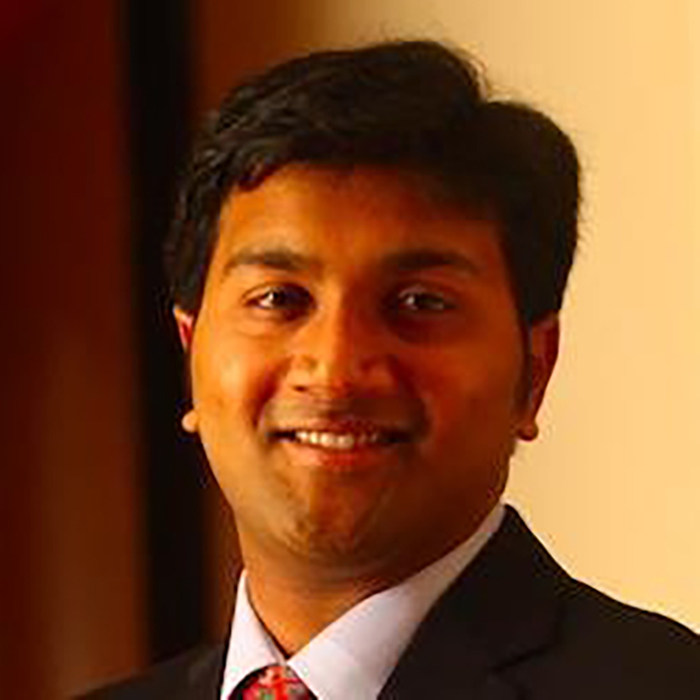 Ryan Godwin, Ph.D.Ryan Godwin, Ph.D., instructor in the Department of Anesthesiology and Perioperative Medicine and the Department of Radiology, and Sandeep Bodduluri, Ph.D., assistant professor in the Department of Medicine and Instructor & Advisor for AI Programming for the Marnix E. Heersink Institute for Biomedical Innovation, have partnered to instruct the institute’s new graduate certificate course, Applications of Artificial Intelligence in Medicine.
Ryan Godwin, Ph.D.Ryan Godwin, Ph.D., instructor in the Department of Anesthesiology and Perioperative Medicine and the Department of Radiology, and Sandeep Bodduluri, Ph.D., assistant professor in the Department of Medicine and Instructor & Advisor for AI Programming for the Marnix E. Heersink Institute for Biomedical Innovation, have partnered to instruct the institute’s new graduate certificate course, Applications of Artificial Intelligence in Medicine.
The institute’s AI in Medicine Graduate Certificate provides current and future health care leaders with important foundations in understanding and applying artificial intelligence (AI), as well as the safety, security, and ethics of using AI to improve the health and lives of patients. The Applications of Artificial Intelligence in Medicine course introduces students to the applications of AI in medicine through machine learning, deep learning, and natural language processing.
The Heersink communications team met with Dr. Godwin and Dr. Bodduluri to discuss the ethics of AI and what students can expect from this new program at UAB.
Q: How did you become interested in AI?
Godwin: As a part of the last generation to grow up without regular access to computers, I was at a transformative age when my parents brought home our first PC. Learning computational skills early on ultimately supported delving into analytical problem solving, and, as I was actively involved in algorithm development while working on my Ph.D. in physics during the initial AI wave, it was a natural progression to begin exploring applications of AI in my work.
Bodduluri: I got my first introduction to medical AI systems in my graduate school at the University of Iowa Biomedical Imaging Laboratories. During our graduate studies, we focused on developing advanced image processing and machine learning workflows for lung disease diagnosis and prognosis. This led my interest to pursue AI and deep neural networks as a specialization and as a career path.
Q: How did you get connected with UAB?
Godwin: I heard about some of the incredible work in AI being done at UAB from my good friend and colleague, Dr. Ryan Melvin. We worked in the same lab during our Ph.D., and it was inspiring to reunite in the Department of Anesthesiology and Perioperative Medicine to continue our fruitful scientific collaboration as part of the Perioperative Data Science team.
Bodduluri: I joined UAB Pulmonary Division in 2016 as a postdoctoral fellow in Dr. Surya Bhatt’s newly established UAB Lung Imaging Lab. Dr. Bhatt was also my graduate advisor at the University of Iowa before he joined UAB Pulmonary. Dr. Bhatt introduced me to UAB and provided an opportunity to conduct advanced AI research to diagnose pulmonary disease, specifically chronic obstructive pulmonary disease (COPD).
Q: Why did you choose to teach the Applications of Artificial Intelligence in Medicine course?
Godwin: The topic of applications of AI in Medicine is something I am very passionate about, and given my experience as an educator and success in building AI models for health care applications, I jumped at the opportunity to teach the course. It is rewarding to help the students improve their AI literacy and enable them better evaluate and interpret the many AI models available and even learn to build their own AI models.
Bodduluri: I have always been interested in medical image processing and acquired expertise in developing medical AI systems through my educational background in biomedical engineering, medical imaging, and software development. I chose to teach Applications of AI in Medicine as the course was designed to introduce several advanced AI concepts toward practical medical applications. This is very close to my current research work as a faculty in the lung imaging lab.
Q: In your opinion, what is the greatest opportunity for AI application in Medicine?
Godwin: The most significant opportunity ultimately rests in AI’s ability to transition care from a population-based approach to a more patient-specific approach based on the comprehensive, detailed patient information provided in modern health care settings. In other words, the most significant opportunity for AI in Medicine is borne from its ability to synthesize and interpret immense amounts of complex data quickly. This feature will help transition care-based decisions from being based on what is best for individuals based on populations of similar patients (i.e. demographics) to what is best based on precise physiological measurements and an in-depth understanding of what is happening to the patient based on their entire physiological makeup (e.g. multi-omics).
Bodduluri: There are several critical applications that we could develop to advance our understanding of disease pathology and save lives. It is challenging to limit to one single greatest opportunity in my view. For instance, AI-based diagnostics has seen great advances in recent times, and at a point where such systems are able to diagnose and predict disease progression accurately in different subspecialties. With the latest advance in large language models, there would be significant progress and opportunity in utilizing these systems towards safer and larger clinical benefits.
 Sandeep Bodduluri, Ph.D.Q: Would you please explain the three core elements of this course: machine learning, deep learning, and natural language processing?
Sandeep Bodduluri, Ph.D.Q: Would you please explain the three core elements of this course: machine learning, deep learning, and natural language processing?
Machine Learning- Applications of AI to EHR data
Bodduluri: This implies the application of neural networks toward a greater understanding of clinical electronic health record (EHR) data. This would allow us to develop disease screening tools to identify patients early and administer precise and personalized therapeutic strategies.
Godwin: With machine learning, computers can be trained to analyze EHR data, learn from it, and make predictions or decisions. In the context of healthcare, this could mean predicting which patients are at risk of developing certain diseases based on their health history, helping doctors diagnose diseases more accurately, suggesting personalized treatment plans, or even identifying trends in larger populations that can help with public health planning. In essence, machine learning in the context of EHR data is about harnessing the power of computers to improve health care by learning from large amounts of data that would be too complex and time-consuming for humans to analyze independently.
Deep Learning- Applications of AI to Medical Imaging data
Bodduluri: Images are everywhere around us, and these images are the largest data mediums we interact with every day. In this context, there has been a significant advancement in the amount of information we can get from one single photograph. As natural images contain information about our surroundings, medical images contain critical information about specific human anatomy and how it changed with disease. The application of advanced AI systems allows us to infer this critical information in greater detail and higher accuracy, thus leading to a better understanding of underlying disease processes.
Godwin: Deep learning is typically a supervised learning technique that involves using neural networks to have the computer algorithm automatically identify what parts of an image are essential to differentiate images (i.e. classification) or pixels (i.e. segmentation). These neural networks have many layers where, at each layer, it learns about more complex features in an image, allowing it to find patterns that might not be obvious to humans. AI has many applications in medical imaging. For example, it can help doctors provide diagnoses, particularly for useful for incidental findings, and automate time-consuming tasks like segmentation which can streamline treatment planning for radiotherapy.
Natural Language Processing- Applications of AI to Clinical Documentation
Godwin: Natural Language Processing, or NLP, is the sub-specialty of AI focused on building models that can interface with natural human language. This includes teaching AI models to understand how to extract meaning from text and even how to create text on their own. The latter (creating text) is often referred to as generative AI because the models make new, never before seen text. There has been a recent leap in the capabilities of generative AI with large language models (e.g. ChatGPT), and this leap is accelerating the changes brought about by AI, particularly in health care.
6. What can students expect to learn from the course?
Bodduluri: This course is designed to educate learners about artificial intelligence and machine learning applications in medicine and will cover the basic concepts required to understand, implement, and assess AI applications in medicine.
Godwin: Students can expect to learn about different application types (e.g. generative AI in Medicine, AI applied to medical images, and AI applied to physiological waveforms), the critical factors to consider when evaluating and building models, and some of the ways these technologies are already reshaping clinical research and work. The instruction incorporates games, like “2 Human 1 AI,” where the students try to guess which text was human-generated to promote engagement and hopefully have a little fun in the process.
Learn more about this program. Applications are due by Dec. 1 for the Spring 2024 semester.